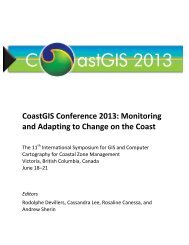in Context the SCotian Shelf - COINAtlantic
in Context the SCotian Shelf - COINAtlantic
in Context the SCotian Shelf - COINAtlantic
You also want an ePaper? Increase the reach of your titles
YUMPU automatically turns print PDFs into web optimized ePapers that Google loves.
ABORIGINAL FAST FACTS<br />
>> The Aborig<strong>in</strong>al population is much younger than<br />
<strong>the</strong> general population with a median age of<br />
25.4 versus 41.6 for <strong>the</strong> total population.<br />
>> 9,557 people (less than 1/3 of <strong>the</strong> aborig<strong>in</strong>al<br />
population) live on reserve <strong>in</strong> Nova Scotia.<br />
>> There are 34 reserve locations across Nova Scotia.<br />
>> A grow<strong>in</strong>g portion of <strong>the</strong> Aborig<strong>in</strong>al population<br />
resides <strong>in</strong> Halifax (5,320).<br />
>> 4,980 aborig<strong>in</strong>al people have knowledge<br />
of an aborig<strong>in</strong>al language.<br />
NS Office of Aborig<strong>in</strong>al Affairs 2008<br />
Confederacy of Ma<strong>in</strong>land Mi’kmaq (Bear River,<br />
Annapolis Valley, Glooscap, Millbrook, Paq’tnkek,<br />
and Pictou Land<strong>in</strong>g First Nations). In 2006, <strong>the</strong><br />
Aborig<strong>in</strong>al population was comprised of North<br />
American Indian (63%), Metis (31.8%); Inuit<br />
(1.3%) and o<strong>the</strong>rs (3.8%) (Nova Scotia Department<br />
of F<strong>in</strong>ance 2008).<br />
O<strong>the</strong>r Aborig<strong>in</strong>al organizations are <strong>the</strong> Native Council<br />
of Nova Scotia and <strong>the</strong> Maritime Aborig<strong>in</strong>al Peoples<br />
Council, which provides a range of services to Aborig<strong>in</strong>al<br />
people liv<strong>in</strong>g off-reserve and <strong>the</strong> Native Women’s<br />
Association which provides Aborig<strong>in</strong>al women with<br />
a voice <strong>in</strong> <strong>the</strong> social, cultural and economic development<br />
of <strong>the</strong> Aborig<strong>in</strong>al community (Nova Scotia<br />
Office of Aborig<strong>in</strong>al Affairs 2011).<br />
3.3 Economic Overview<br />
By improv<strong>in</strong>g our understand<strong>in</strong>g of <strong>the</strong> role of<br />
<strong>the</strong> ocean <strong>in</strong> <strong>the</strong> economy, decision-makers are<br />
more <strong>in</strong>formed when develop<strong>in</strong>g policies aimed<br />
at protect<strong>in</strong>g <strong>the</strong> mar<strong>in</strong>e environment, support<strong>in</strong>g<br />
susta<strong>in</strong>able activities and communities, and<br />
provid<strong>in</strong>g leadership <strong>in</strong> ocean stewardship. Nova<br />
Scotia’s gross domestic product (GDP) <strong>in</strong> 2009<br />
was $34 billion (Nova Scotia Department of<br />
F<strong>in</strong>ance 2011). Between 2003 and 2007, <strong>the</strong><br />
economy of <strong>the</strong> prov<strong>in</strong>ce grew by 4.9%. Nova<br />
Scotia’s economy is largely service based, with<br />
76% of its GDP generated by service <strong>in</strong>dustries<br />
and only 8% aris<strong>in</strong>g from natural resource<br />
based <strong>in</strong>dustries. (CBCL Ltd. 2009). Activities<br />
dependent on <strong>the</strong> ocean make a substantial<br />
contribution to <strong>the</strong> Nova Scotia economy. In<br />
2005 an overview of <strong>the</strong> Economic Value of<br />
<strong>the</strong> Nova Scotia Ocean Sector was prepared<br />
by Gardner P<strong>in</strong>fold and subsequently updated<br />
<strong>in</strong> 2009. Gardner P<strong>in</strong>fold (2005) def<strong>in</strong>es <strong>the</strong><br />
ocean economy as “all private sector activities<br />
with a direct dependence on <strong>the</strong> ocean or<br />
ocean resources. This <strong>in</strong>cludes extractive uses<br />
(e.g., fish<strong>in</strong>g, oil and gas production) as well as<br />
non-extractive dependence (e.g., shipbuild<strong>in</strong>g,<br />
transportation). It also <strong>in</strong>cludes public sector<br />
organizations and agencies with direct ocean<br />
responsibilities.” The direct GDP impact of <strong>the</strong><br />
ocean sector <strong>in</strong> <strong>the</strong> Nova Scotia economy is<br />
estimated at $2.6 billion and accounts for 8.1%<br />
of <strong>the</strong> prov<strong>in</strong>cial GDP (Table 2; Gardner P<strong>in</strong>fold<br />
2009). When sp<strong>in</strong>-off effects of ocean activity <strong>in</strong><br />
<strong>the</strong> broader economy are considered, <strong>the</strong> GDP<br />
impact rises to just under $5 billion, just over<br />
15% of Nova Scotia’s GDP. The Scotian <strong>Shelf</strong><br />
economy has not been separated from <strong>the</strong><br />
Nova Scotia ocean economy as a whole.<br />
Household <strong>in</strong>come, a major component of prov<strong>in</strong>cial<br />
GDP, also benefits greatly from ocean activity.<br />
Just over 5.7% of prov<strong>in</strong>cial household <strong>in</strong>come is<br />
directly attributable to ocean activities. The impact<br />
rises to over 10% when sp<strong>in</strong>off effects are considered.<br />
Employment impacts are similarly impressive.<br />
With <strong>the</strong> equivalent of just over 30 000 direct<br />
full-time jobs created, <strong>the</strong> ocean sector accounts<br />
for about 6.8% of total prov<strong>in</strong>cial employment.<br />
The impact rises to just under 14% when sp<strong>in</strong>off<br />
effects are <strong>in</strong>cluded (Gardner P<strong>in</strong>fold 2009).<br />
http://co<strong>in</strong>atlantic.ca/<strong>in</strong>dex.php/state-of-<strong>the</strong>-scotian-shelf<br />
33













